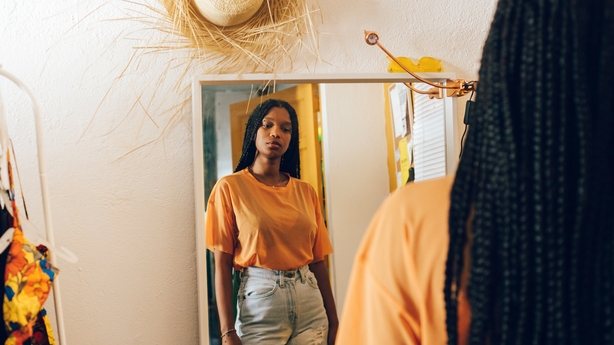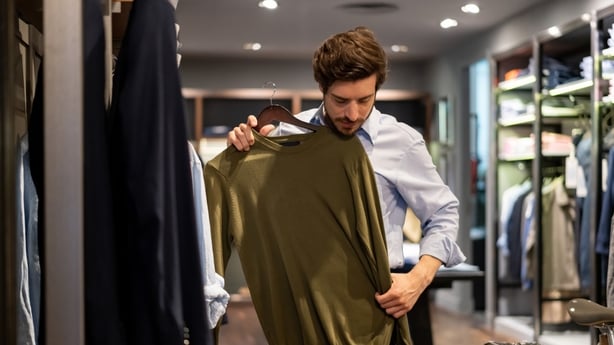For those of us who dread the fitting room, we have likely found a way to circumvent the difficulty of finding clothes that properly fit, be it going a size or two up, favouring certain fabrics or sticking to the one shop we know and trust.
However, overall, there is little push back at the discrepancies in sizing in fashion. Although videos decrying the differences in sizes between brands have almost become their own trend, social media is still replete with videos of influencers and shoppers buying items in three, four, five different sizes – and even then, there's no guarantee any will fit.
And you can't blame them either: these are the rules we learn to play by when the game is skewed. The knock-on effects, however, are obvious: low self-esteem, higher spending and the inevitable environmental consequences of sending so much produce back.

With all of this now so seemingly commonplace, we rarely stop and think that maybe it's not us, or even the label on the clothes that doesn't fit. Maybe it's the fabric that needs tweaking, not our bodies.
It was while working as a fashion technologist that Shana Chu hit upon this lesser known faulty cog in this system. Having worked in fashion for 10 years, with projects that included designing GAA jerseys and safety checking fire suits, the Irishwoman has launched Tailr, a start-up that uses AI to monitor how fabrics are constructed and then how they behave once the production process starts.
Brands, Chu explained, go through lengthy processes to create their designs, but a multitude of factors in production can result in items that vary in sizes despite being labelled S, M or L. This could be a misshapen bolt, a dye that distorts the fabric or, Chu said, even the humidity in the factory.
The software analyses everything from the dyes and chemicals used to the weave of the fabric, and uses rigorous testing to see how the fabric handles. The company has recently raised €700,000 and has an eager customer base across the world.
It reinforces her message that often it is not our bodies that don't fit the size, but rather the other way around. More often it's the fabric that simply doesn't fit one body as well as it might another person's.

"Fabric is just like water", she said. "It's a very liquid thing. It can change based on how you handle it. Even someone sitting at a machine, if they handle it tighter than the person sitting next to them, that can have an effect on the fabric."
Brands are increasingly aware of the need to reform sizing. As Chu noted, there's intense pressure on them to be more size inclusive, but to do that "they first need to have consistent sizing".
How we came to sizing as we know it is a complicated, and relatively recent, story. Modern sizing began in the early 20th century, and in 1941 Ruth O'Brien and William Shelton published their report 'Women’s measurements for garment and pattern construction', based on their Work Projects Administration study.
This project recorded the measurements and weights of 58 women, most of whom were middle-class, white and young. These measurements formed the basis of wider commercial clothes production, elbowing out made-to-measure shopping and leading to the establishment of a series of even numbers eight through 38 to represent overall size.
This size bias has continued throughout the ensuing decades, with many shoppers of different ethnicities, physical abilities and gender expression crying out for clothes that better represent them.
More complicated still, is 'vanity sizing' – as the "standard" body size began to get larger, retailers started to cut their sizes more generously to make customers feel better about themselves. This has led to its own distortion.
Research from The Washington Post in 2015 found that a US size eight dress (a UK 12) was nearly the equivalent to a US 16 (UK 20) in 1958.

Arguably no other item of clothing so encapsulates this struggle as jeans do. Finding the right pair for your body can, and does, take months if not years, and as many will know, the experience of squeezing into a design clearly not made for your body shape can be extraordinarily upsetting. "It can literally make or break your day in a fitting room", Chu said.
She added that denim is one of the most notoriously difficult fabrics to handle due to how it shrinks or relaxes during production.
Standard sizing, where each retailer is producing and selling clothes to the one set of measurements, is sometimes floated as a solution: make everything uniform and it takes the guess work out of shopping. Of course, bodies aren't all uniform, so standard sizing remains largely unrealistic and potentially unhelpful.
"I don't think we will [get standardised sizing] because brands always want to have their own size profile. I think to get standardisation, we just need to talk about consistency within the brand", Chu said.
She noted that many retailers strive to create their own size guide, like a signature, which is created using fit models with the type of body that they believe matches their customers'.
However, the time, effort and money it takes to get to know your size in various shops is simply not possible for many shoppers.
Better sizing may be out of reach depending on your means: A US study found that more expensive women's trousers often had larger sizes than cheaper brands. Most will find something that "does the job", despite not being wholly happy with their purchase.

With more brands striving to be environmentally conscious, it's in their best interest to reduce the amount of stock being sent back as a result of customers trying to find the best fit. "When you do that, it actually goes through approximately seven pairs of hands to go back into stock from the brand", Chu said. "Overproduction is about 15% to 25%, sometimes as high as 30%."
She added that she's seeing more people buying two of the same size, because the measurements can vary so drastically between them – a concerning trend considering 50% of online fashion purchases are returned.
An awareness of fabric can also remind us of where our clothes come from, Chu said: "Sometimes people are so far removed from clothing that they don't realise that there's someone sitting in front of a sewing machine sewing that up.
"I think sometimes people forget that clothing starts in a field with someone picking cotton."

There is only so much we can do to educate ourselves on how fabrics perform throughout the production process; we simply don't have that kind of visibility as shoppers.
Chu agreed: "I think it's very tough to put the onus on the end shopper because it's a minefield to try and understand and know all of this. There is textile experts in the industry, and they still find it hard to go out and shop for items.
"Even for me, when I'm in a shop and I see garments and it can still even affect me, and I know that it hasn't been produced correctly so it can be hard to get that out of your head."
Her advice: "Do not pay attention to the label. If your normal size is one thing and you end up buying another thing, do it. Go and wear what looks good and fits good. If that means you have to go up four sizes, do it. If it means you have to go down four sizes, do it."

